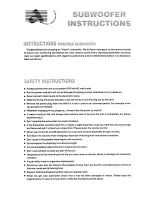
Enclosure Construction
Please observe the following suggestions
when building an enclosure for GTi Series
subwoofers.
1. Choose an enclosure design from the
Enclosure Design Sheet included with
your subwoofer.
2. Use at least 3/4" (19mm) MDF (medium
density fiberboard) or marine birch
plywood to build the enclosure.
Enclosures for 12" and larger
subwoofers and smaller woofers driven
by high-power amplifiers should be
constructed using 1" (25mm) material.
3. Join pieces of wood with glue and
screws; do not use nails. Once the box
has been tested, seal all joints inside
the box with silicone caulk.
4. Fill the enclosure with damping material
(dacron, fiberglass insulation or
long-fiber wool) according to the design
you have chosen from the Enclosure
Design Sheet. “0% fill” indicates
that no damping material
should be used; “50% fill”
indicates that all interior walls
except the baffle should be
lined with 1" thick damping
material, and “100% fill”
indicates that the box should
be loosely stuffed with
damping material.
5. Use PVC or ABS plastic pipe for ports.
Keep in mind that the openings at either
end of the port must be at least one port
diameter away from any obstruction.
6. Use the 10/24" machine screws and
T-nuts provided to mount the woofer to
the baffle. See Figure 1.
Figure 1. Mounting the GTi woofer
in its enclosure
Dual Coil Versus Differential Drive
®
(patent pending)
Conventional dual-voice-coil woofers use
a pair of voice coils “interwound” on the
former and centered in the magnetic gap.
The two coils may be connected in series
or parallel in order to maximize an
amplifier’s output power. Both coils drive
the cone forward and rearward. X
max
(one-way-linear) is determined by the
amount of voice coil exposed above
and below the top plate. A conventional
voice coil is made up of several layers of
windings, each transferring heat to the
winding next to it until the heat is finally
dissipated by the outside layer through
the top plate, magnet and backplate. This
arrangement is inefficient, and results in
low thermal power handling. See Figure 2.
Figure 2. Conventional dual-voice-coil design
JBL GTi Series subwoofers employ
Differential Drive, a technology developed
by JBL Professional. Differential Drive
employs two voice coils positioned at
opposite ends of the former, each
suspended in a separate magnetic gap.
These two coils may be connected in series
or parallel, like a conventional DVC woofer,
to maximize an amplifier’s output power.
Both coils MUST be connected to the
amplifier in correct polarity! At low power,
both voice coils drive the woofer’s cone,
and any motor nonlinearities are cancelled
by the out-of-phase coils and gaps. As
power input increases so that one coil rides
completely out of its gap, force is still
applied to the cone by the other coil. At
extremely high power, each coil will enter
T-NUTS
(PROVIDED)
10/24"
SCREWS
(PROVIDED)
TOP PLATE
POLE PIECE / BACKPLATE
CONE
SPIDER
BOTH COILS
DRIVE CONE
FORWARD
AND
REARWARD
MAGNET
OVERHANG DETERMINES
X
max
04
The Official Brand of Live Music


























